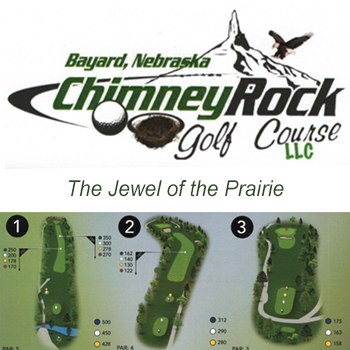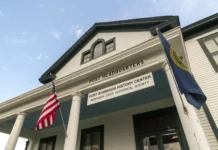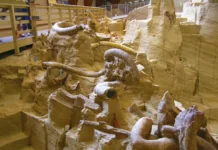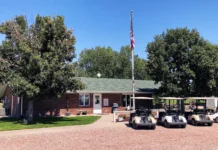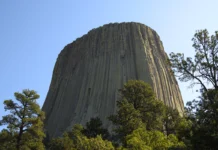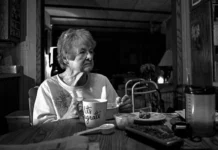| WYOMING |
Visit the ruins of Fort Laramie’s third hospital and first lime grout structure, built on top of unmarked graves, including the daughter of a famous Sioux warrior, on the site of the original Post Cemetery.
| THE BATTLE-HARDENED WARRIOR
Fort Laramie, which operated as a military post from 1849 until 1890, had three hospitals during its tenure. The first, located inside the adobe trading post known as Fort John before its sale to the U.S. Army, was overrun by vermin, suffered severe structural defects, and was moved in 1856 into a wood and adobe brick building. The only remains of this second hospital are hidden beneath the prairie, with no ruins above ground.
The third and final post-hospital was located on a hill a short distance from the main fort buildings. However, this was also the post cemetery site, and before any work could begin on the new structure, soldiers dug up and reburied six bodies found within the construction zone. Around the hospital’s perimeter, dozens of other burials were abandoned, the markers removed, and the bodies left in the ground and forgotten.
Among those whose bodies were buried in the original post cemetery was a beloved daughter of the famed Brule Sioux chief, Spotted Tail, named Mni Akuwin-– Brings Water Home.
Spotted Tail, whose murder in 1881 had a critical impact on Native laws and tribal sovereignty lasting to the present day, was a battle-hardened warrior who, after being imprisoned for two years at Fort Leavenworth in Kansas as punishment for his participation in the Grattan Massacre of 1854, had become convinced of the futility of attempting to stop the endless rush of white settlers, soldiers, and gold seekers into his homeland, and become a statesman and peacemaker between his people and the US government. After one last battle, which resulted in the city of Julesburg, Colorado, being burned to the ground in February of 1865, Spotted Tail and his followers fled to the Powder River country of Wyoming and Montana.
| MNI AKUWIN – BRINGS WATER HOME
Mni Akuwin was born around 1848 and traveled to Fort Laramie each year with her family to trade and pick up the food and clothing promised to them by the United States government. A favorite of the officers and their wives, she was considered a pet and called “princess” by many at the fort.
In the winter of early 1866, which had been particularly brutal for the Brule, Mni Akuwin died at the estimated age of 16 or 17. The cause of her death, from either pneumonia, tuberculosis, or simply illness due to malnutrition, is lost to history. Still, before her death, she asked her father to bury her at Fort Laramie.
Fifteen days after her passing, traveling ahead of the main body of Brule Sioux, who was on their way to Fort Laramie for peace talks, Mni Akuwin’s family arrived at the post. They had traveled some 260 miles from the upper reaches of the Powder River, on foot and horseback in one of the most savage winters in memory, to reach the post and carry out a dying child’s last wish.
At sunset on March 8th, 1866, a horse-drawn ambulance carried Mni Akuwin’s body, followed by her relatives and nearly the entire garrison of Fort Laramie, an estimated 600 off-duty officers, to the burial ground at the top of the hill.
The fort’s carpenters had built a cedar coffin, and a seven-foot-high scaffold was erected in the Sioux tradition of sky burials. Inside the coffin, Mni Akuwin was buried in her finest clothing and given a pair of gauntlets by Colonel Maynadier, the post commander, to keep her hands warm on her journey to the spirit world. A buffalo robe was then wrapped around her body, and her coffin was covered with a red wool blanket donated by the post’s trader Colonel William G. Bullock.
The Post Chaplain, Alpha Wright, stated in his account of the funeral to the St. Louis Democrat that after her body was raised onto the platform, the two ponies who had carried her body between them on a litter were killed at the burial site. Their heads and tails were nailed to the posts of the scaffold. He also transcribed part of the speech given by Post Commander Maynadier before Mni Akuwin’s funeral, after Maynadier had received a message from Spotted Tail asking to bring his daughter to the post for burial, which urged peace and promised aid to Spotted Tail and his people:
“Let them come. Look at that flag… You see a red stripe and a white stripe side by side, and they do not interfere with one another. So the red man and the white man may live in this country in harmony. I think your daughter’s funeral should be at sunset, everything will be prepared, and as the sun goes down, it will remind you that your daughter has gone from your lodge, but as the sun rises so your daughter will rise again, and you will see her again in the Great Spirit.”
Mni Akuwin’s body rested, undisturbed, on this platform until 1876, when Spotted Tail had her remains moved from Fort Laramie and buried at what is now the Spotted Tail Cemetery in Rosebud, South Dakota. This event is cause for debate, as a grandson of Spotted Tail stated, sometime after WWI, that Mni Akuwin’s remains were taken down from the scaffold and buried, but that Spotted Tail did not transport her body to South Dakota. So it’s entirely possible that Mni Akuwin is buried near the Post Hospital in one of the many unmarked graves surrounding it and may even be buried beneath the building.
Completed in 1873, the Post Hospital was the first building at Fort Laramie constructed using lime grout, a type of poured wall construction that the army was so impressed by; they afterward used it on nearly every primary structure built at the post.
Lime grout is made by burning native limestone in a kiln, driving off the carbolic acid to create a calcium oxide, a white, highly acidic, crystalline solid commonly known as quicklime. Coarse gravel, taken from the nearby Laramie River, was mixed with water and the quicklime to form mortar. Poured into box forms made of 2 by 12-inch planking, this mixture hardened for at least 24 hours. The forms were removed, placed on top of the hardened mixture, and again filled with wet lime grout. The process was repeated until the wall reached the desired height.
The Post Hospital was a state-of-the-art facility in the 1870s. It had twelve beds for patients, a large, well-ventilated ward, and a veranda for patients to use in warm weather, along with a kitchen, dining room, dispensary for medications, dining room, indoor lavatory, and offices, all surfaced with smooth white plaster to make cleaning and disinfection easier.
At the rear of the building were the quarters of the hospital steward, a non-commissioned officer who oversaw the daily administration of the hospital. His wife was often appointed the hospital’s matron if the steward married. She washed and distributed clean clothing and bedding to the hospital patients and cooked their meals with food provided by the hospital’s garden. The post hospital also kept a milk cow, chickens, and pigs to supply the patients with milk, eggs, and meat. Being the only hospital within a 100-mile radius, civilians were also treated and charged $1 per day while they were under the post-surgeon’s care.
After the fort was abandoned in 1890, the roofs, windows, and doors were stripped from the post’s buildings, including the hospital, and the lime grout, with a lifespan of only 20-40 years, began to deteriorate rapidly. Today, preservation crews at the park fight a never-ending battle against time and the elements, sealing cracks and patching exposed surfaces with the same materials used in the 1870s.
During your visit to the Post Hospital, please treat this area like any cemetery due to the unmarked graves surrounding the building. Stay on the marked paths, don’t attempt to climb on the ruins, keep an eye out for rattlesnakes, and only take pictures, not souvenirs.
| RESOURCES
Story by: Kathrine Rupe
Photography by: Hawk Buckman




